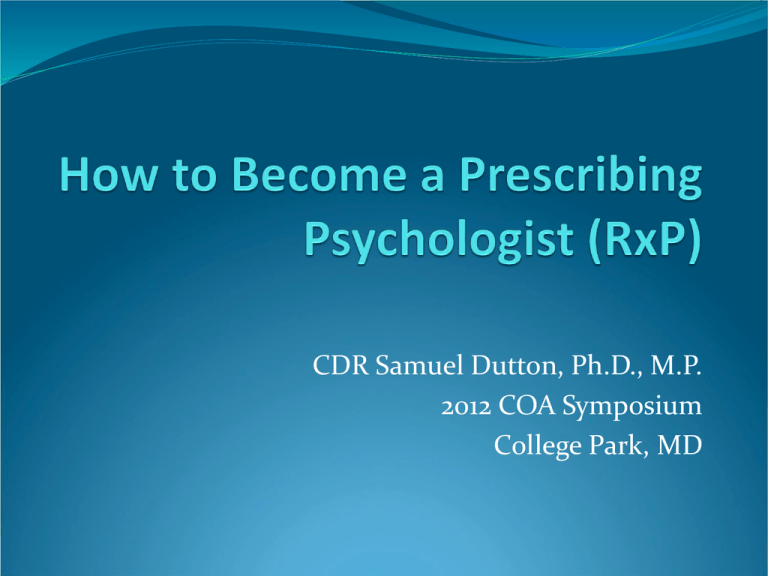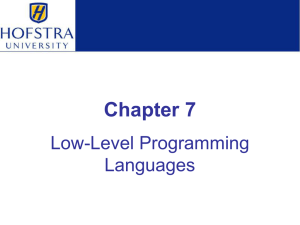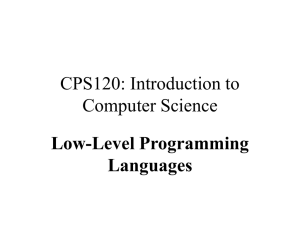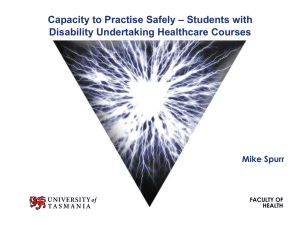Presentation
advertisement

CDR Samuel Dutton, Ph.D., M.P. 2012 COA Symposium College Park, MD Working the Steps…. 1. Choose a state (LA or NM) 2. Choose a degree program 3. Apply for psychology licensure 4. Plan for the PEP 5. Complete your degree program 6. Take and pass the PEP 7. Apply for RxP state licensure 8. Apply for CDS number (DEA & state) 9. Seek prescription privileges at your facility 10. Obtain a supervisor for your initial prescribing 11. Obtain independent privileges to prescribe 12. Continuing medical and psychopharm education 1. Choose a state LA – Must obtain “concurrence” on all scripts from patient’s primary care provider. Does not require a period of supervised practice. NM – Receive a conditional prescribing certificate, then have to prescribe under the supervision of a licensed physician for 2 years. 1. Choose a state What do you need in LA?: A Master of Science in Clinical Psychopharmacology degree A passing score on the PEP (you have 3 tries) A license to practice psychology in Louisiana You apply to the Louisiana Board of Medical Examiners 72 Medical Psychologists in Louisiana now 1. Choose a state What do you need in NM?: A Master of Science in Clinical Psychopharmacology degree from New Mexico State U./Southwestern Institute NM may make an exception if you fly to NM for their hands- on Physical Assm’t course (1 weekend/month x 6 months) 80-hour practicum in clinical assessment (two weeks straight, primary care medicine) 400-patient-hour physician-supervised practicum treating at least 100 patients with mental disorders A passing score on the PEP A license to practice psychology in New Mexico You apply to a joint NM board of psychology and medicine 30 prescribing psychologists in NM now (12 are conditional) 2. Choose a degree program There are only 4 that award you the accredited postdoctoral degree: Alliant University – first and oldest, biggest, completely distance learning Fairleigh Dickensen Univ. – based in New Jersey, almost all distance learning Nova Southeastern Univ. – Florida, must attend classes in person (1x/month) Southwestern Institute/NM State Univ. – NM’s program, must attend in person PEP Performance: Postdoctoral Psychopharmacology Training Programs 2000-2007, APA Practice Organization, 2007. PEP Passing score: 106 (70%) % Who n Mean SD Average Fail Pass NOVA Southeastern U. 12 112.3 6.1 75% 15% 85% Mass Schl of Prof Psyc 11 109.1 7.9 73% 35% 65% Prescribing Psy Register 13 111.2 14.0 74% 35% 65% Alliant Int'l Univ 74 110.1 13.9 73% 38% 62% NM State Univ 10 107.1 11.2 71% 46% 54% Fairleigh Dickinson U. 49 105.5 15.4 70% 51% 49% Georgia State U. 16 101.9 14.2 68% 61% 39% Illinois Schl of Prof Psyc 5 100.2 5.7 67% 84% 16% Total 190 107.9 13.1 72% 44% 56% 3. Apply for standard psychology licensure in NM or LA Start one or two years early so this doesn’t become a rate-limiting step, especially if you don’t have the Certificate of Professional Qualification (CPQ from ASPPB). Both LA and NM accept the CPQ, NM also accepts Nat’l Register. NM has no oral exam, but using CPQ in LA allows you to bypass LA’s oral exam (even though you still have to meet with the Board). 4. Plan for the PEP What you learn in your degree program isn’t entirely what you need to know. Focus on the actual practice of RxP, get as familiar as you can with the drugs, their side effects, mechanisms of action, lab values, common medical conditions, etc. If at all possible, work with the drugs, e.g. with a family practitioner who sees patients who need psychotropic meds. You will not have time to review everything before the PEP, so REVIEW AS YOU GO ALONG. 5. Complete your degree program Ideal scenario: 1 day per week = 8 hours study time Used commute time Burned leave when really necessary Advantages of not attending lectures real time 6. Pass the PEP Commit to taking it within 6 months of graduating: Once APA’s Practice Organization approves your application to take the PEP you have a 3-month window to take it. There is a practice PEP of 75 questions; use this as a gauge as soon as you graduate (Professional Examination Services via TestTrac.com website). If you fail the PEP, you need to devote serious time to your next attempt - more time per week than you did for your degree courses. 7. Apply for RxP licensure Once you pass the PEP, you apply for your RxP license. In LA, this is straightforward and quick. In NM this is involved, you must have also completed: the 80-hour clinical medicine practicum 400-patient-hour psychotropic medication practicum Documentation burden is significant 8. Apply for CDS number (DEA & state) Controlled and Dangerous Substances (Schedules II- V) – you need to obtain a Drug Enforcement Agency number to prescribe these drugs. It’s a $500 fee for 2 years, but if you are working in a federal agency, you may apply for a “fee-waived” DEA number. State pharmacy boards also have a CDS number, you need to get this before you apply for your federal DEA number. 9. Seek prescription privileges at your facility (= get credentialed) Suggestion # 1: Usually the fewer psychiatrists at your facility, the better. Zero might be a good number. Closer to residency is more friendly than senior. Military is more friendly than civilian. Suggestion # 2: The smaller the agency that credentials you, the better. E.g., a 100-staff clinic is better than a 1,000staff medical center. Suggestion # 3: The more credibility and support you have from family practice physicians, the better. So far, only the military and IHS have credentialed RxP’rs (and 1 community clinic in Las Cruces, NM). The military has officially endorsed RxP in all 3 services, but several RxP’rs have been shot down at the military treatment facility level, especially in the Army. 10. Obtain a supervisor for your initial prescribing This will be mandatory in the military for independent credentialing. Military regs require the supervisor to be either a psychiatrist or a prescribing psychologist. For NM licensure this is mandatory. Supervisor must be “a licensed physician knowledgeable of the administration of psychotropic medication”. If you practice in LA, no supervisor is required, just primary care provider concurrence (until MPAP). 11. Obtain independent privileges to prescribe Navy: must see 100 patients (not just 100 encounters), this mirrors APA’s recommended RxP training model. Air Force: must be supervised for 1 year. Army: must be supervised for 1 year, and it must start within 24 months of passing the PEP. IHS: So far, everyone in IHS has gone through NM, and two years of supervision is required under NM’s conditional prescribing certificate. 12. Continuing medical and psychopharm education Louisiana Medical Board requires about twice as many annual CEU’s to maintain your MP license as does the Psychology Board to maintain your psychology license Stephen Stahl’s Neuroscience Education Institute Daniel Carlat’s Psychiatry Report Louisiana Academy of Medical Psychologists (4x/year) Be aware of Big Pharma There is always more to know….but it is interesting! Questions?... Feb 18, 2005 – John Bolter, PhD, MP, becomes the first state-licensed psychologist to prescribe medication.











